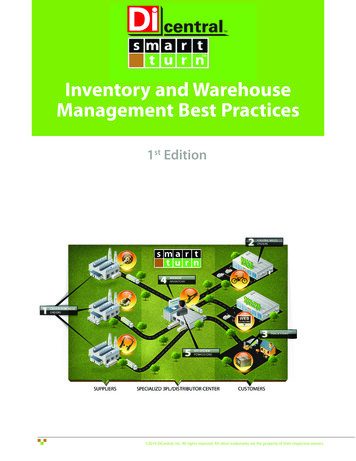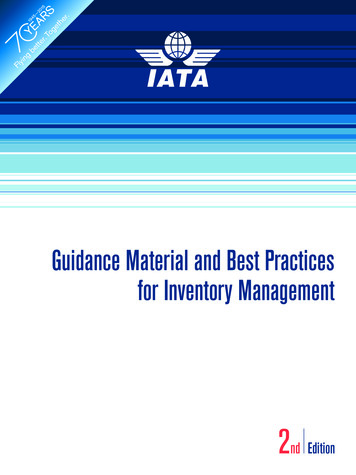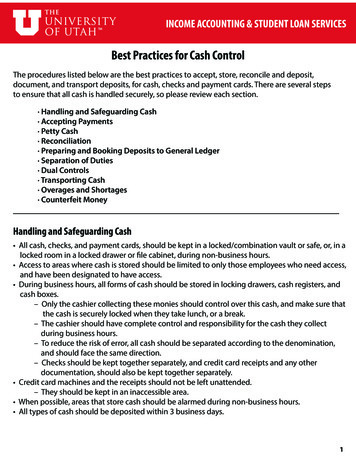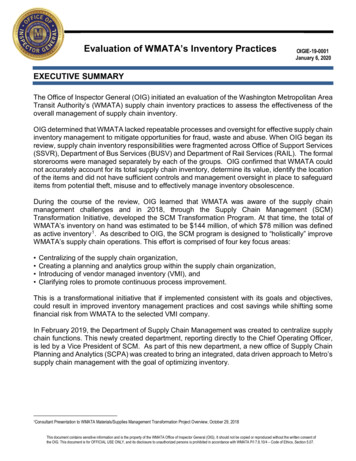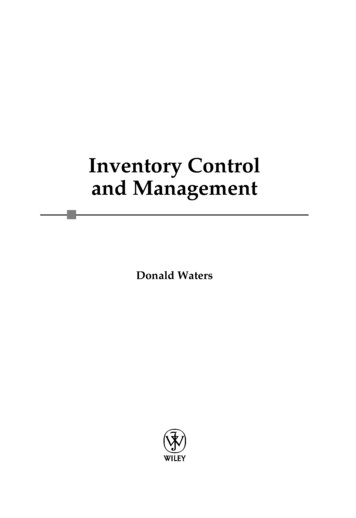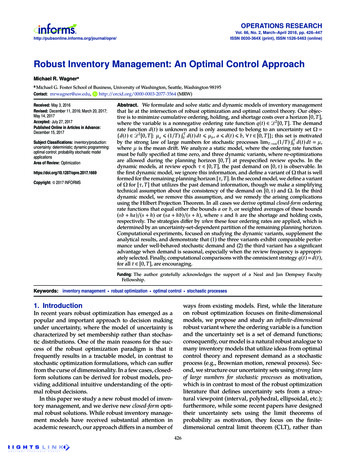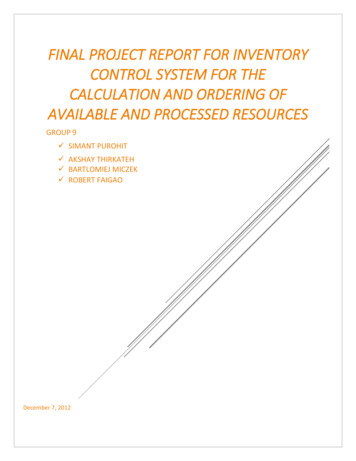
Transcription
Best Practices for Inventory Control UsingDynamics GP
Inventory Humor
Agenda Sales Inventory Valuation Methods Reason Code Troubleshooting Cost Issues Taking Physical Inventory Counts Landed Cost Review Quantity Tolerances Reporting
Inventory Valuation MethodsIn Great Plains, the cost posted to General Ledger differs among differentinventory valuations methods. GP supports the following Valuation Methods:FIFO valuation method or LIFO Perpetual valuation method" The Actual Cost is posted to the General Ledger when the item is received inInventory. The Actual Cost is posted to the General Ledger when the item issold, decreased, or transferred.“Average perpetual valuation method" The Actual Cost is posted to the General Ledger when the item is received inInventory. The Average Cost is posted to the General Ledger when the item issold, decreased, or transferred.“FIFO valuation method or LIFO Periodic valuation method" The Actual Cost is posted to the General Ledger when the item is received inInventory. The Standard Cost is posted to the General Ledger when the item issold, decreased, or transferred."
Inventory Valuation Methods (continued)Inventory value differs according to the adopted valuationmethod, as shown below:FIFO or LIFO Perpetual Valuation On Hand Quantity isMultiplied By the Cost at which Item Was ReceivedAverage Perpetual Valuation On Hand Quantity is MultipliedBy The Current Cost of the ItemFIFO or LIFO Periodic Valuation On Hand Quantity isMultiplied By The Standard Cost of the Item
Inventory Valuation Methods (continued)Valuation MethodFIFO PerpetualAndLIFO PerpetualAverage PerpetualFIFO PeriodicAndLIFO PeriodicPro’s Easy Management & Easy forInventory and GL Reconciliation Purchase Receipt and Stock Statusalways Shows the Cost whichappears in GLCon’s Cost Of Sales will be determine byfirst/last layer of receiving This needs to look into purchasereceipt detailBack dated posting will affect alreadyOne Cost For All sales which appears in Posted Receipt and already postedItem CardSales, which creates variancescontinuouslyHelps if company wishes to havestandard costing for period of timeIt requires periodic Cost revaluationwhich increase inventory managementtask
Reason CodeUsed to identify causes and track costamounts for item stock movementsand adjustments.They can be assigned to a line itemon: inventory adjustments variances transfer stock counts
Reason CodeExamples for reason codes: spoilage lost inventory damage by accident in the facility damage by accident in transit inventory movement due to space issues other reasons why your inventory is movedRestrict certain codes for situations when reporting inventorymovement or losses:Ex. reporting inventory loses by spoilage or damage can only be used fornegative adjustments in inventory transactions
Reason Code
Reason Codeǀidentify trends that you can use to improve operationsby noting reasons behind inventory movement or lossesHigh ratesof inventoryloss due indinventorymovementsStreamlinewhereinventory isstoredYou can improve productivity byoptimizing inventory storage and howyour team moves inventory aroundfor manufacturing or pack and shipoperations.
Reasons why inventory can become out of balancefrom the General LedgerTroubleshootingCost IssuesReasons why cost can get out of “Whack”ReconcileHistorical Stock Status Report vs Historical InventoryTrial BalanceAdjust Cost Utility
Reasons why inventory can become out of balance from theGeneral Ledger Adjustments to inventory were entered directly into the general ledger and were not reflected inInventory in Microsoft Dynamics GP. An Increase Adjustment batch was posted in Inventory, but the Post to GL check box was notselected on the batch. When the batch was posted, it did not post to the general ledger. A Decrease Adjustment batch was posted in Inventory, but the Post to GL check box was notselected on the batch. When the batch was posted, it did not post to the general ledger. An Increase or Decrease Adjustment batch was posted in Inventory. The Post to GL check box wasselected on the batch. However, the batch has not yet been posted through to the general ledger. An override existed for an item. An Increase adjustment in Inventory was entered. A cost differenceexisted between the original sale and the new shipment. The cost variance was not manuallyposted to the general ledger. An override of a Serial Type item in Sales Order Processing or in Invoicing was entered. A new SerialNumber was added automatically. Then, the transaction was posted. This will not create a PurchaseReceipt in Inventory or update the general ledger with the inventory shipment. An override of a Lot Type item in Sales Order Processing or in Invoicing was entered. A new lotnumber was added automatically. Then, the transaction was posted. This will not create a PurchaseReceipt in Inventory or update the general ledger with the inventory shipment.
Reasons why can get cost out of “Whack” Purchase Order received in withincorrect unit cost Inventory adjustment made withincorrect unit cost
ReconcileTheReconcileProcessThe quantities arereconciled first betweenthe Purchase Receipts andthe Item Serial NumberMaster fileReallocating of Inventory Transaction Amounts Work,Inventory Serial and Lot Numbers Work, Sales TransactionAmounts Work, Sales Serial/Lot Work and History,Invoicing Transaction Amounts Work and Invoicing Serialand Lot Number Work tablesThen the Purchase Receiptsand Item Lot NumberMaster files are reconciledThe quantities arereconciled between thePurchase Receipts file andItem Quantity Master fileThe On Order quantitiesare determined for theItem Quantity Master andItem Vendor Master tablesby comparing them to thePurchase Order Line andPurchasing Receipt LineQuantities tablesReconcile the quantities oneach of the items’individual quantity locationrecords to the totalquantity record for thatsame item
Taking PhysicalInventory Counts Physical Count Cycle Counts GP Stock Count Schedule Smartlist / Integration tool Data Collection Solutions Blue Moon Quality Count Willoware Complete Count
Physical Count Physical Inventory is a “ Call to ARMS” Generally During Shutdown Forced Vacation Time Pressure to Finish and Reconcile Untrained Employees Counting Stuff They Know Nothing About Lost and Found Proven Methods. Real Results. People Do Not Like the Task How Long Does the Inventory Stay Accurate?
Cycle Count No Down Time One Hour or Less per Day First Thing in the AM Uses Those Familiar With the Product Count Different Items Each Day Counts Items Based Upon Some Relative Usage Criteria Frequency Varies Based Upon Importance and Proven Methods. Real Results. Number Of Items to CountA – Most frequently Counted - 30 DaysB – Frequently Counted – 90 DaysC – Least Frequently Counted – 180 Days
GP Stock Calendar/Schedule Stock count calendar explains how to create and modify a stock count calendar—the calendar the system will use to determine the days when a stock count mightbe done. Count intervals in Inventory Control describes how you can specify a count intervalfor groups of items. Stock count schedules used to create a stock count schedule—a list of the specificitems at a specific site that will be counted during a specific count. If you’re usingmultiple bins, you also can specify the bins that will be included in the stock count.When you're ready to begin a stock count, use the Stock Count Schedule windowto determine which items at which sites will be counted. Stock count processing contains information about entering the results of a stockcount, working with default variance transactions, and generating the stock countaccuracy report. Information about using the report also is included. Head Ach Difficult lookup capabilities.
Smartlist / Integration Tool Create SmartList export to excel Add additional columns as needed Populate Count Import variance column as inventory adjustment using integration toolsuch as Integration Manager, SmartConnect or Scribe
Data Collection
Blue Moon Quality Count
Willoware CompleteCount Tools needed to perform a controlled cycle count in Dynamics GP usingstock tags. provides for an audit trail of the count ensures a higher degree of accuracy keeps downtime to a minimum Works with the Dynamics GP Stock Count module. Once items have been assigned to a cycle count: Start printing tags and attaching them to physical locations throughout thewarehouse Tags will be used later by employees performing the count to record theinventory located in the vicinity of the tag Print and distribute tags ahead of time to prepare for the count without havingto freeze inventory
Willoware CompleteCount Print Assigned or Blank Tags Assigned Tags are produced one per Item-Site (or Item-Site-Bin) on the Count Assigned Tag Examples: 1-Per Page, 2-Per Page, 3-Per Page Blank Tags are used to perform a “Blind Count”, where the tags are placedthroughout the warehouse and counters record on the sheets what is in theimmediate zone of the sheet(s) Blank Tag Example: 1-Per Page, 2-Per Page, 3-Per Page “Start” the Dynamics GP Cycle Count This creates a snapshot of the current On Hand quantities for the items on thecount. This quantity is referred to as the Captured Quantity. Inventory is counted and recorded on the tags The tags are entered into the CompleteCount Tag Entry window The system will automatically tally the total count for an item if it hasquantities recorded on several different tags
Willoware Complete Count Adds Stock Count Filters to the Stock Count Schedule and Stock Count Entrywindows Provides the ability to quickly locate specific Items in the count with a number ofrestriction/search criteria All printed tags must be accounted for before the count totals can besubmitted Total count quantities will appear in the Dynamics GP Stock Count module When the Dynamics GP Stock Count module processes the final count it creates theneeded inventory transactions ExcelLink provides another level of cycle counting support Exports the stock count to Excel Users can enter count information in multiple copies of the spreadsheet When the spreadsheets are imported, CompleteCount adds them together to arrive ata total count, which is then used to update the GP Stock Count.
Landed CostsThe total cost of a shipment from it’sorigin to it’s destination.Costs included are typically the purchase price,freight and taxes, but also can contain other costssuch as customs fees.
Landed Cost Components Landed Cost Records These are required and are the individual cost component records. Some keyinformation for these records: Vendor IDCost Calculation MethodInvoice MatchRevalue InventoryAccounts Landed Cost Groups These are optional and can be used as a way to group certain costs that needto be applied to items together.
Entering Landed Costs Entering Purchase Orders Any line item that has a default Landed Cost Group, will have that groupdefaulted on the Purchase Order Line Item. Receiving Inventory When a shipment transaction is entered, we use the Landed Cost Button toapportion the costs across all lines that match the particular landed costs (i.e.Freight, Customs, etc.). Invoice Match When it’s time to match our vendor invoice, we either match the landed coststo the same vendor as the goods or create another invoice to match the landedcost vendor (i.e. Delta Air Lines for Freight). If there is a variance from whatwas received, inventory can be revalued so the “landed cost” of the item isaccurate.
Quantity TolerancesQuantity Tolerances provide a way tospecify a percentage overage orshortage on Purchase Order receivingwhen ordering goods either on astandard or blanket purchase order.Quantity Tolerances can be assignedfor Sales Inventory or DiscontinuedItems.
ShortagesIf the quantity received is short within the percentage ofthe quantity ordered, the line item is automaticallychanged to change order, received or closed (dependenton whether or not the line item has been invoiced) Example Quantity Ordered of 100 Shortage tolerance percent set to 10% Enter receipt for 91 Remaining quantity is canceled and status of the lineupdated to Received or Closed if the item has been fullyinvoiced.
OveragesIf using an overage quantity tolerance, you can limit thetotal quantity you can receive over the quantity ordered.When over the tolerance, you will receive a message thatyou can’t enter the quantity. Example Net order quantity is 100 (quantity ordered – quantitycancelled) Overage tolerance percent set to 10% Quantity received 110 or less, no message Quantity received 111 or more, message displays
Reporting/AnalyticsDynamics GP ReportsCustom ViewsSalesPad DashboardSocius Analytics
Common GP Reports UsedStock Status Report Can be printed at any time for anat-a-glance report of the currentstatus of your inventory. Includes: Quantity on hand Quantity allocated Quantity back-ordered Quantity on order Current cost Extended costHistorical Stock StatusReport A list of posted transactions inInventory Control Sorted by item and includes audittrail information. Print this report if you select tomaintain transaction history in theInventory Control Setup windowHistorical Inventory TrialBalance Report (HITB) Shows your inventory value as of aspecific date or date range and thevalue of the five different quantitytypes Use this report to balance yourinventory value with theappropriate accounts in GeneralLedger.
Custom y-sql-views/
Salespad DashboardThe SalesPad DashboardDesigner harnesses thepower of the DevExpressDashboard functionality togive users new andpowerful tools to visualizecompany data.
Socius Analyt
Count intervals in Inventory Controldescribes how you can specify a count interval for groups of items. Stock count schedules used to create a stock count schedule—a list of the specific items at a specific site that will be counted during a specific count. If you’re using

